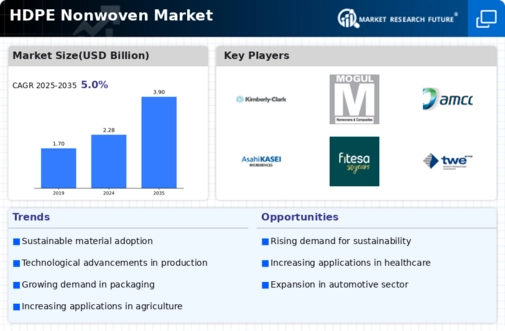Market Growth Projections
The Global HDPE Nonwoven Market Industry is characterized by robust growth projections, reflecting its increasing relevance across multiple sectors. The market is anticipated to reach a value of 2.28 USD Billion in 2024, driven by rising demand in packaging, healthcare, and other applications. Furthermore, the industry is expected to experience a compound annual growth rate of 4.99% from 2025 to 2035, indicating a sustained upward trajectory. This growth is attributed to factors such as technological advancements, sustainability initiatives, and the diverse applications of HDPE nonwoven materials. As industries continue to adopt these materials, the market's expansion appears promising, suggesting a bright future for HDPE nonwoven products.
Sustainability Initiatives
Sustainability initiatives significantly influence the Global HDPE Nonwoven Market Industry, as manufacturers and consumers alike increasingly seek eco-friendly alternatives. HDPE nonwoven fabrics, being recyclable and produced from high-density polyethylene, align well with global sustainability goals. This shift is particularly relevant in regions with stringent environmental regulations, where companies are compelled to adopt sustainable practices. The industry's growth is further supported by the rising consumer awareness regarding plastic waste and its environmental impact. As a result, the market is expected to expand, with projections indicating a value of 3.9 USD Billion by 2035, highlighting the potential for HDPE nonwoven materials in sustainable applications.
Rising Healthcare Applications
The healthcare sector's growing reliance on nonwoven materials significantly impacts the Global HDPE Nonwoven Market Industry. HDPE nonwoven fabrics are increasingly utilized in medical applications, including surgical gowns, masks, and drapes, due to their barrier properties and comfort. The ongoing emphasis on hygiene and infection control in healthcare settings drives demand for these materials. As the global population ages and healthcare needs evolve, the market for HDPE nonwoven in medical applications is poised for expansion. This trend aligns with the overall growth trajectory of the industry, as evidenced by the projected market value of 2.28 USD Billion in 2024, underscoring the importance of healthcare applications.
Growing Demand in Packaging Sector
The Global HDPE Nonwoven Market Industry experiences a notable surge in demand driven by the packaging sector. As industries increasingly prioritize lightweight and durable materials, HDPE nonwoven fabrics emerge as a preferred choice for packaging applications. This trend is particularly evident in the food and beverage sector, where the need for hygienic and moisture-resistant packaging solutions is paramount. The market is projected to reach 2.28 USD Billion in 2024, reflecting a growing recognition of HDPE nonwoven's advantages. Furthermore, the anticipated growth in e-commerce and retail sectors further fuels this demand, suggesting a robust trajectory for the industry.
Diverse Applications Across Industries
The versatility of HDPE nonwoven fabrics across various industries serves as a key driver for the Global HDPE Nonwoven Market Industry. These materials find applications in sectors ranging from agriculture to automotive, showcasing their adaptability and functionality. In agriculture, HDPE nonwoven fabrics are employed for weed control, soil stabilization, and crop protection, while in automotive, they are used for interior components and insulation. This broad applicability enhances the market's resilience and growth potential. As industries continue to explore innovative uses for HDPE nonwoven materials, the market is expected to witness sustained growth, with projections indicating a value of 3.9 USD Billion by 2035.
Advancements in Manufacturing Technologies
Technological advancements in manufacturing processes play a crucial role in shaping the Global HDPE Nonwoven Market Industry. Innovations such as spunbond and meltblown technologies enhance the production efficiency and quality of HDPE nonwoven fabrics. These advancements enable manufacturers to produce lightweight, high-strength materials that cater to diverse applications, including medical, automotive, and construction sectors. As production capabilities improve, the cost-effectiveness of HDPE nonwoven products increases, making them more accessible to various industries. This trend is likely to contribute to a compound annual growth rate of 4.99% from 2025 to 2035, indicating a promising future for the industry.






















Leave a Comment